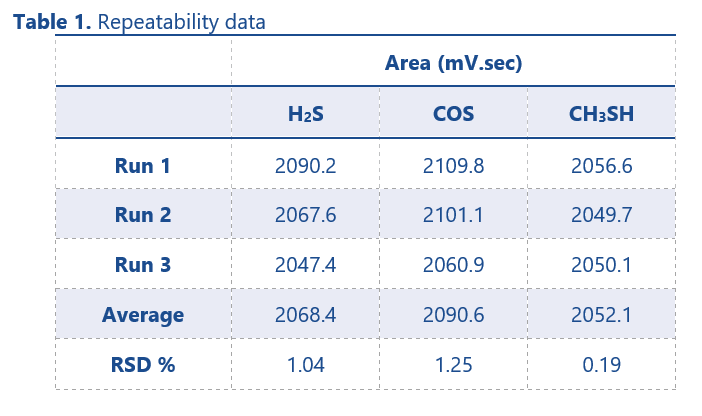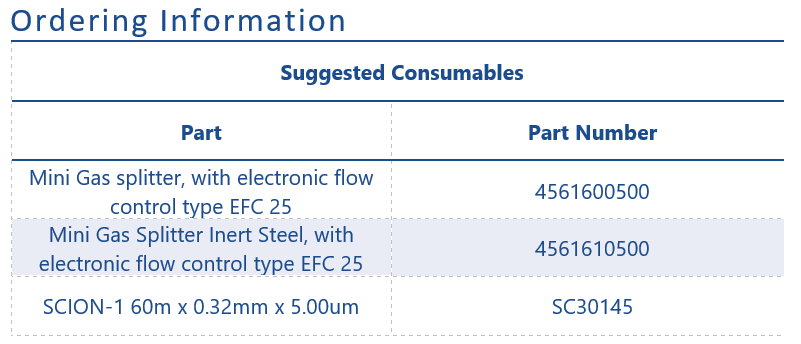The Mini Gas Splitter: SCION Instruments’ Tool to Improve Analytical Accuracy
Introduction
This application note discusses the SCION Instruments mini gas splitter and its ability to improve analytical accuracy. The importance of sulfur removal from various energy sources can be beneficial for many reasons, such as toxicity, corrosion and environmental pollution. Before crude oils are distilled or coal is converted for the use of fuels, sulfur is first removed from the raw feed streams. H2S is formed during these conversions and treatment steps. When natural gas is extracted from their sources, the gas is treated in gas treatment plants before being used as an energy source. The H2S, COS and other organic sulfur in the gas are removed from the raw materials.
The analysis of sulfur containing components in different industrial gases is a widely performed measurement in an industrial environment. The methods for the measurement of the sulfur containing compounds can be very broad. The analytical method used is dependent on the range and composition of the gas. A GC with pulsed flame photometric detector (PFPD) is usually the detector of choice. Especially with methods where low and ultra-low (ppb) sulfur levels are to be determined.
Handling gaseous streams contaminated with low levels of sulfur requires special attention, mainly because of the reactive nature of the components; they tend to be adsorbed onto most materials. The analytical effect is more drastic at lower concentration levels. For optimal results attention should be given to the transport of gas by sampling into specially treated containers and taking care when transferring the sample on to the analytical instrument.
Figure 1 SCION min gas splitter
Experimental
Once inside the GC, the sample may come into contact with various locations where potentially irreversible adsorption may take place before it reaches the detector. Concentration is determined at the detector; losses in the sample pathway prior to the detector will not be identified, leading to errors in the final reported results.
By making use of inert materials, deactivated steel transfer tubes, a fused silica separation column and avoiding large volumes in the sample path we reduce all adsorption sites in the sample flow path to deliver the highest level of sample transfer to the detector.
The SCION Instruments mini gas splitter is used to handle the sample on route to a capillary column, once it has passed via a large sample loop and valve. The sample loop is large to allow for sufficient sample sensitivity for trace analysis. If the loop and valve were stainless steel they would absorb sulfur, but because the injection valve and loop are composed of inert Hastelloy-C, no sample adsorption takes place during the injection process. The mini gas splitter serves as the alternative for a standard injector.
The advantages of the mini gas splitter are its small size and its deactivated materials. The use of EFC 25 guarantees optimal splitting characteristics as you would expect from a standard injector. The separation column is a 60 meter, 5μm SCION 1 column; a thick film column avoids adsorption onto the column material.
Figure 2 SCION Instruments 8500-GC equipped with the 8400PRO Autosampler.
Figure 3 Chromatogram overlay of the same sample: with (bleu chromatogram) and without (red chromatogram) mini gas splitter
Results
Figure 3 shows an overlay of 2 chromatograms of a sample containing 11ppm each of H2S, COS and CH3SH in nitrogen; one sample was analysed using the mini splitter and one without. The detector used by SCION is the sulfur specific PFPD, operated in sulfur mode (S-mode). This detector shows high sulfur specific response with almost infinite sulphur/carbon selectivity.
The blue chromatogram shows analyte detection when the mini gas splitter was used and the red chromatogram shows detection without the mini gas splitter. Repeatability data
(Table 1), using the mini gas splitter was evaluated over three injections. In combination with the observed equimolar response towards sulphur proved that no adsorption occurs when using the mini gas splitter.

Conclusion
With the use of the mini gas splitter the adsorption has been eliminated. The use of the PFPD provides equimolar response to sulfur and provides good repeatability.
For more information, please contact:
E: sales-eu@scioninstruments.com
W: www.scioninstruments.com




